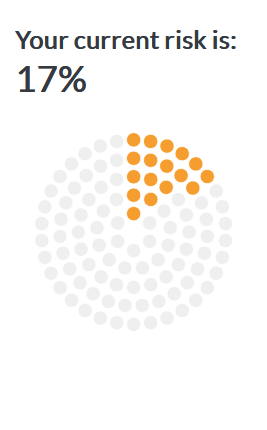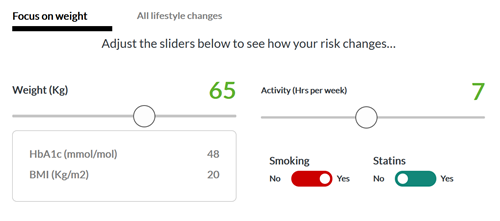Our Risk Prediction Service
This risk tool is designed to give you a rough indication around your likelihood of having a serious diabetes event, but more importantly how you can reduce that risk. There are lots of things you can do to stay well and reduce your risk of developing diabetes complications. Keeping active and eating well are really important. Both of these things will not only improve your mood and make you feel more energised in the short term, but will help you build towards a healthier future. The government recommends at least 150 mins of moderate intensity activity every week. Eating a varied and balanced diet and limiting salt, fat and sugar will help you to manage your blood sugar levels. Limiting portion sizes may help with maintaining a healthy weight.
The risk prediction tool works by analysing information from published research studies and information from thousands of people with diabetes. It looks at which characteristics make people more or less suspectable to serious diabetes events. It will then apply this learning to the information that it knows about you from your diabetes health record. Inaccurate information will lead to inaccurate predictions. If you have any concerns about the results given by this tool, or the information (data) being used to make the predictions, then please speak to your healthcare team.
This tool cannot predict the future – no one can! It aims to give you some rough guidance. More importantly it has been designed to show you the potential impact of positive lifestyle changes (such as giving up smoking, losing weight and increasing activity). We hope you can use these insights to help you work towards a healthier future.
On the left-hand side of this page, you can see your current likelihood (risk) of developing diabetes complications. On the right-hand side is your likelihood of developing complications if you were to make some changes to your lifestyle (e.g. reducing your weight, increasing your activity levels).
Your likelihood of developing complications in the next 2 years is represented here through a visualisation of 100 dots.

For a person with a 20% risk of complications, 20 of the dots will appear coloured rather than grey. In other words, if there were 100 people with the same health status as that person, 20 of those people would be expected to develop a diabetes complication within 2 years.
Towards the bottom of the page, you will see sliders giving you the option of altering your lifestyle choices to see the impact this could have on your future risks. There are two ways of doing this: you can focus on changing your weight (by selecting the ‘Focus on weight’ tab), or you can select the ‘All lifestyle changes’ tab instead. In either case, you can change the chosen parameters by dragging each of the sliders along and seeing how these changes could reduce your risk.

The main difference between the tabs is that the ‘Focus on weight’ tab reduces the glucose (HbA1C) level automatically as you lose weight (as this is what happens in real life). The ‘All lifestyle changes’ tab allows you to independently adjust all the parameters (weight, glucose (Hba1C), activity and statin use). Statins are tablets commonly used to lower cholesterol; cholesterol is a fat in the blood that contributes to furring or hardening of the arteries leading that can contribute to heart attacks and strokes. Many people with diabetes (particularly those over age 50) are advised to take statins to reduce their complications risk.
Finally, if you select some lifestyle changes and want to save these as goals for yourself, you can click on the ‘Save these settings as goals’ button at the bottom of the page.

This will take you to the ‘Set goals’ page. There, you will also find some relevant resources relating to the goals you have set.

